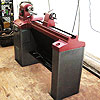Hello,
I am in th eprocess of making a bookcase headboard for my three year old sons bed. I still have lots of work to do but am at a point where I will be installing the backerboard on the headboard to close in the shelves. After the glue up of the dadoes, I am left with two small areas that need to have some material removed in order to allow the backerboard a tight, gap free fit. Basically (as you will see in the photos)I have about 1/16th of material to remove from the two vertical dividers in the centre area of the headboard.
My question to you folks is, What is the best way to do this and have it all blend together nicely? I realize that I could this with chisels but that is a little harsh and I don't think I would really to be able to do it all that clean this way. I guess the best way would be with a chisel plane or bullnose plane but I own neither.
So, I am looking for suggestions on how you would clean this material out and blend it nicely to allow the backerboard to fit in and fit well. Hopefully I have explained this well enough and thank you for your help as always.







 Reply With Quote
Reply With Quote










